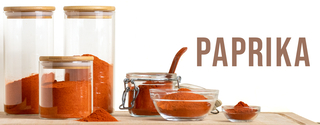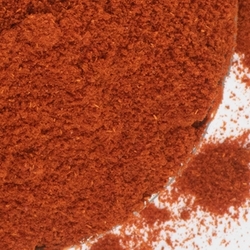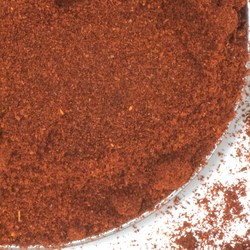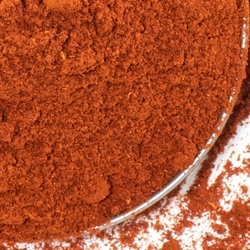Spice Cabinet 101: Paprika
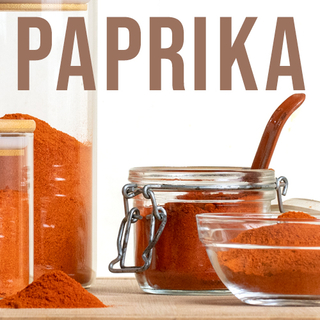
What is Paprika?
Paprika is a vibrant, scarlet-colored spice made from finely ground red peppers that were allowed to ripen on the vine. This spice is a pantry staple around the world. Paprika is often sweet and mild, though it does have some varieties that are spicy and hot or flavored with smoke.
Paprika can be made from several different varietals of the chile pepper family Capsicum annuum, though the different peppers all tend to be of the relatively long, tapered kind with thinner flesh. Fat, thick-fleshed sweet peppers, like a standard Bell pepper that you’ll find in your average grocery store, often don’t dry well enough to make a ground product and are prone to mold. They are valued for their bright red color as much as--or even more than--their flavor. The American Spice Trade Association, or ASTA, came up with a scale to measure paprika's color. The ASTA score goes from 50-180; 85 is a standard-grade color value. As the numbers go up, the color of the paprika is more saturated and vibrant.
Where Does Paprika Come From?
There is no easy answer to where paprika comes from. While paprika is closely associated with Hungary and Hungarian cuisine, paprika peppers did not arrive in that part of the world until the mid to late 16th century. The origin of all peppers can be traced to South America, where they grew wild and were distributed throughout South and Central America, mostly by birds. Eventually, peppers were cultivated, and native traders travelling through these regions carried them across the Caribbean as cargo in dugout canoes.
When Christopher Columbus landed in the Bahamas in 1492, he was the first European to have an encounter with any sort of chile pepper plant. He brought the ancestor of all paprika back with him to Europe and specifically to his patrons, the Spanish monarchs Ferdinand and Isabella. The king and queen did not care for their fiery heat and sent them to a monastery to be studied. These monks sent them further along across Spain and Portugal. From there, chile peppers made their way across Europe. Some peppers stayed spicy, like those in Calabria, but other European cultures experimented with their breeding and created the sweet and flavorful varieties of peppers that give us paprika today.
Types of Paprika 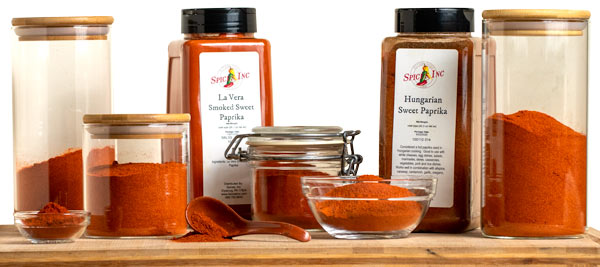
There are three different types of paprika; this spice is either sweet, or hot, or smoked. Understanding these three characteristics often help determine where a particular kind of paprika is from. “Regular” paprika tends to be sweeter, not really hot, and can be from California, Hungary, or South America. There are 8 different kinds of Hungarian paprika, and they can be sweet, hot, or pungent, and range in color from vibrant red to light brown. Spanish paprika is usually smoked, and can be mild or hot.
The "Regular" Paprika
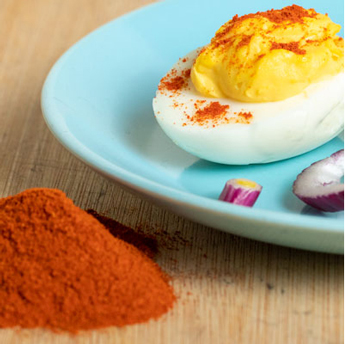 “Regular” paprika, also called American, sweet, basic, or Domestic Paprika, is what’s found in most grocery stores. It is gentle and earthy with an unassertive flavor. Regular paprika is never smoked. It makes a terrific backdrop for more strongly-flavored ingredients, so it’s often used as a flavor base in dry rubs or blends. It is often favored for its ability to deliver a bold, red color.
“Regular” paprika, also called American, sweet, basic, or Domestic Paprika, is what’s found in most grocery stores. It is gentle and earthy with an unassertive flavor. Regular paprika is never smoked. It makes a terrific backdrop for more strongly-flavored ingredients, so it’s often used as a flavor base in dry rubs or blends. It is often favored for its ability to deliver a bold, red color.
This paprika is delicious when added to cheeses, chicken, duck, egg dishes, hors d'ouvres, rice, salads, smoked foods, vegetables, and cottage cheese. It’s also terrific in salad dressings, where it not only adds color but also acts as an emulsifier.
Regular paprika is not necessarily the product of one specific chile but rather, can be a combination of several different peppers that meet the correct heat and color requirements. It usually comes from New Mexico, California, Hungary, or South America.
Hungarian Paprika
Paprika is Hungary’s national spice; you’ll find it on tables right next to the salt and pepper, and you can’t make time-honored Hungarian food, like goulash, without a heaping helping of paprika. Paprika peppers are grown all over the country though Kalocsa and Szeged, cities located in southern Hungary, are two of the most important regions for paprika production.
It’s thought that paprika was introduced to Hungary sometime before 1550 and was first adopted by shepherds and fishermen, who found paprika to be a welcome, and spicy, addition to their more humble foods. The plants, with their pretty white flowers and vibrant red pods, were at first used decoratively in more aristocratic circles but by 1569 were being written about in reference to edible agriculture.
This spice has been thoroughly incorporated into Hungarian culture. There are eight paprika flavor and appearance profiles in Hungary; they range from különleges, sweet and mild, and a brilliant red, to erős, which is spicy and a dusky orange-brown color that can be as hot as the hottest jalapeno. Paprika marketed in the US as Hungarian Sweet Paprika is usually classified as édesnemes paprika; fiery red, but with a mellow flavor and just a touch of pungency.
Hungarian Paprika is often found in casseroles, white cheeses, chili, egg dishes, marinades, rubs, salads, stews and it also goes well with most vegetables, pork and rice dishes.
Spanish Paprika
Spanish paprika, or pimentón, is a celebrated spice throughout that country, with controlled production that must be monitored to meet traditional standards in how these peppers are grown and processed. Murcia, in southeastern Spain, produces paprika that is sweet and mild. Paprika produced in La Vera, found in western Spain, can be sweet, spicy, or bittersweet. The celebrated pimentón de La Vera are smoked for extra flavor.
La Vera Smoked Hot Paprika
La Vera Smoked Hot Paprika, also known as picante, is a Spanish paprika that has been smoked the traditional way – in a drying house, over oak wood, for a period of 10-15 days. The end result is a spice that exhibits a deep, dark earthy red color and mild, but noticeable, heat. This spice measures approximately 500 - 1,000 on the Scoville Heat Unit Scale.
Smoked Paprika adds authentic flavor to Spanish-style paellas. It's a key ingredient in Spanish chorizo and dry-cured lomo pork loin. In American cuisine La Vera Smoked Hot Paprika has become a secret ingredient used in pork barbecues, chicken kebabs, and hearty beef and lamb stews.
La Vera Smoked Sweet Paprika
La Vera Smoked Sweet Paprika is also known as dulce. Much like its spicier cousin, this sweet paprika is made by drying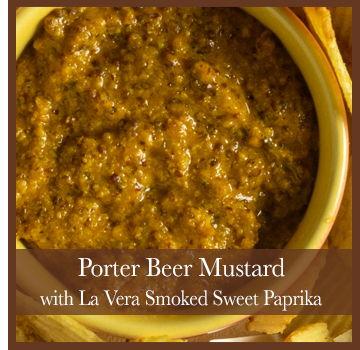 freshly-harvested, ripe, red peppers in low-lying, adobe smoke houses. They are placed of smoking grills fired with slow-burning oak planks. After smoking, the paprika is milled by electrically powered stone wheels which must turn very slowly, as heat from friction adversely affects the signature color and flavor.
freshly-harvested, ripe, red peppers in low-lying, adobe smoke houses. They are placed of smoking grills fired with slow-burning oak planks. After smoking, the paprika is milled by electrically powered stone wheels which must turn very slowly, as heat from friction adversely affects the signature color and flavor.
Use La Vera Smoked Sweet Paprika to make tapas like patatas bravas—roasted potatoes with a seasoned aioli—or artichokes simmered in garlic sauce. It’s wonderful in Spanish style stews, on roasted chicken or fish, and in a classic Spanish romesco sauce, blended from tomatoes and bell peppers and thickened with bread and almonds.
No matter what kind of paprika you choose, make sure you cook it with some kind of liquid. All paprika contains a relatively high amount of natural sugar, so exposure to direct heat on the bottom of the pan can burn it very easily. Because of their very different flavor profiles, we do not recommend substituting smoked paprika for regular paprika, or vice-versa.
Unless a recipe specifies otherwise, you’ll maximize your flavor with paprika by adding it later in the cooking time. Prolonged exposure to high temperatures can degrade both the color and the flavor from paprika, creating a less attractive dish.

